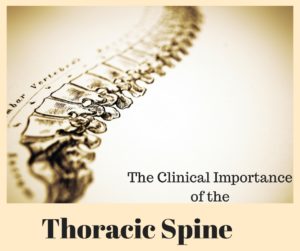
The thoracic spine (mid-back) and ribcage are body regions that are commonly overlooked or perhaps only briefly ‘skimmed over’ during many clinical examinations for the cervical and lumbar spine. Because neck and low back pain are far more common than thoracic and/or rib pain, the middle spine is often not addressed as much as it should be in treatment. It is fairly common in today’s clinical practice for physical therapists to consider the function of joints immediately above or below the location of a patient’s primary pain as potential contributors to a dysfunctional system. For example, if a patient’s knee hurts, hopefully a therapist will evaluate not only the knee, but also the ankle and the hip. However, when considering the spine, which is in its entirety a chain of 33 interconnected segments, a clinician may be attempting to consider joints above and / or below the painful region, yet still be taking too narrow a view of the interdependence of more global spinal regions.
Often, pain in the spine is most immediately arising from an excessively mobile segment: a segment that moves ‘too much’. Therapy is often focused on ‘stabilizing’ the area with too much movement. It is commonly recognized that a hypermobile segment generally has one or more relatively ‘stiff’ segments above and/or below it. Whether or not these regions are ‘normal’ or ‘too stiff’ is a question that requires clinical judgement. Hopefully, if less mobile segments are judged to be ‘too stiff’, these regions are also addressed during treatment by encouraging movement in the area. Restoring a relative balance of movement and workload throughout a spinal region tends to relieve pain and restore appropriate movement. Smooth rotation of all cervical spine levels together allows adequate turning of the head for safe driving, for example.
In the spinal column, the cervical (neck) region is meant to be fairly mobile on the whole. The lumbar (low back) region is also fairly mobile. Relatively, the thoracic spine is meant to be stiffer. In part, this is due to the fact that the ribcage attaches to the spine, & is a sturdy protective structure around the heart and lungs. If a spine is functioning normally, all of its segments move just the right amount to enable full global movements, like bending to touch the toes or arching backward to allow us to look up. When parts of the spine start to function abnormally, over time some segments tend to start moving too much – doing more than their share of the movement workload. Other segments tend to stop moving, creating excessive limitation to movement. In our modern society, where the majority of jobs involve sitting at a desk, bending forward over a keyboard, the thoracic spine is prone to becoming even more stiff than it should be, forcing other more mobile portions of the spine to do excess work. Excess work then causes pain. Pain tends to cause tension – muscle clenching, anxiety, guarded movement, etc. These factors then can in turn exacerbate pain. A vicious cycle ensues.
When a patient seeks treatment for the common complaints of neck or back pain, a broad examination of all spinal segments is warranted. Addressing the dysfunctional segments of the cervical or lumbar spine is only part of the answer to resolving pain if, as is often the case, the thoracic spine and ribcage are also in disrepair. Completely appropriate neck or back treatment may still achieve only temporary or partial relief of pain symptoms, if problems with mid-back mobility are not also addressed. Restoring appropriate movement in the thoracic region and ribcage in addition to the more immediately painful cervical or lumbar spine allows for normalization of the total mobility workload of the spine. Accomplishing this task results in more effective, longer-lasting resolution of pain.
At Symmetry, we frequently find in our clinical practice that a comprehensive approach to care for the spine – including adequate focus on optimizing mobility in the thoracic spine and ribcage – has a dramatic and positive effect on patients’ treatment outcomes. If you have questions about how thoracic and ribcage function might be contributors to spinal pain, please be in touch.
